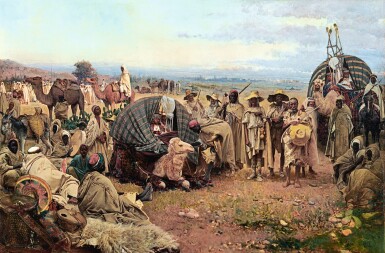
GUSTAVO SIMONI | THE HALT OF THE CARAVAN
Auction Closed
October 22, 05:34 PM GMT
Estimate
100,000 - 150,000 GBP
Lot Details
Description
GUSTAVO SIMONI
Italian
1846 - 1926
THE HALT OF THE CARAVAN
signed and dated G. Simoni. 1885 lower right
oil on canvas
61 by 90cm., 24 by 35in.
Sale: Sotheby's, London, 22 November 1983, lot 13
Richard Green, London (purchased at the above sale)
Mathaf Gallery, London
Purchased from the above
London, Mathaf Gallery, Spring Exhibition, Important Orientalist Paintings of the 19th century, 1984, illustrated in the catalogue
Lynne Thornton, Women as Portrayed in Orientalist Painting, Paris, 1985, pp. 100-101, catalogued & illustrated
Caroline Juler, Najd Collection of Orientalist Paintings, London, 1991, p. 215, catalogued & illustrated
In the heat of the coastal plain of Kabylia in northern Algeria, a camel caravan makes a halt on its journey across the desert. Simoni approaches the subject in an almost photo-realistic manner. Shaded from the heat, the women travellers are glimpsed resting atop the backs of their camels under attatichs or palanquins, structures commonly used to protect women and children from the sun. In the foreground, Simoni captures barefooted men in their ragged clothes, facing the viewer with an uncompromising gaze as if staring into the lens of a camera. Far from portraying travel in a romantic or glamorous light, this composition succeeds in conveying the true hardship of necessary caravan journeys across the desert.
Simoni first visited Algeria in around 1879, his appetite to experience the Muslim world whetted by the Moorish history he encountered on trips to the Andalusian cities of Seville and Granada. He set up a studio in the ancient Algerian hill town of Tlemcen, where he established a base for his painting expeditions throughout the country. Like his American contemporary Frederick Arthur Bridgman, also a frequent visitor to Tlemcen, Simoni was interested less in the topography of the North African landscape and more drawn to documenting the unvarnished, daily life of its people. Works like the present one express a profound empathy towards—and understanding of—these nomadic tribespeople.
This painting reprises a watercolour of the same year in the permanent collection of the Victoria & Albert Museum, London.
